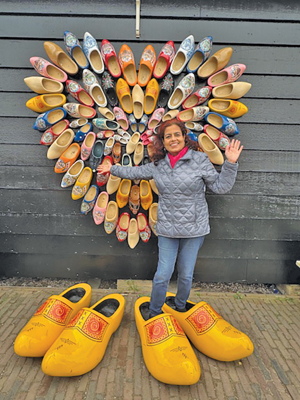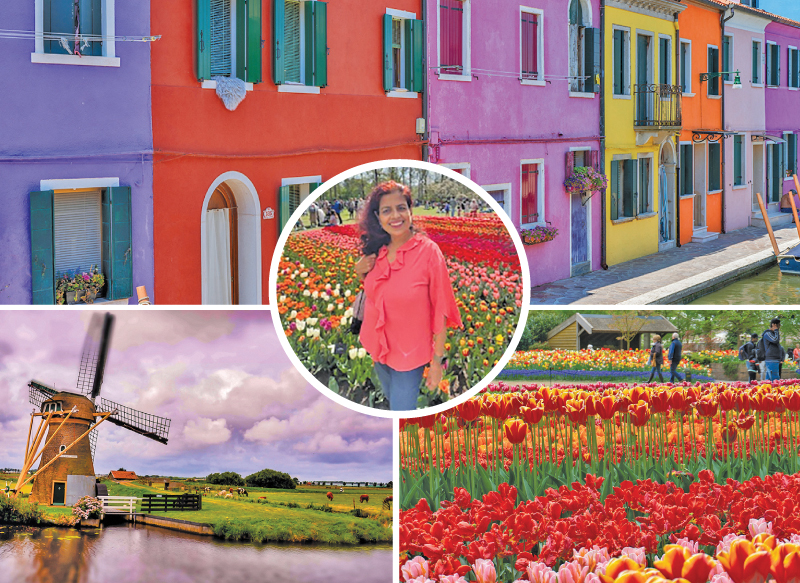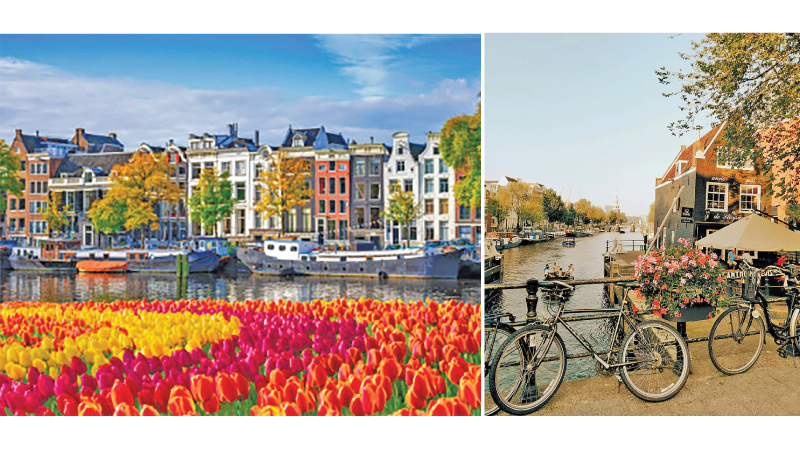 Would you believe that a humble lumpy brown bulb could transform into one of the world’s most photographed wonders? In the Netherlands every spring millions of tulips burst into bloom turning vast farmlands into living art and attracting travelers from all over the world. While Amsterdam’s canals, art museums, and stroopwafels are legendary, it’s the tulip that steals the spotlight from March to May—painting the city in vibrant hues. This humble tulip bulb has not only changed the Dutch landscape, but it has reshaped its economy, culture and identity over the years.
Would you believe that a humble lumpy brown bulb could transform into one of the world’s most photographed wonders? In the Netherlands every spring millions of tulips burst into bloom turning vast farmlands into living art and attracting travelers from all over the world. While Amsterdam’s canals, art museums, and stroopwafels are legendary, it’s the tulip that steals the spotlight from March to May—painting the city in vibrant hues. This humble tulip bulb has not only changed the Dutch landscape, but it has reshaped its economy, culture and identity over the years.
Having grown up watching Bollywood films, the iconic scene from Silsila, of lovers dancing through endless tulip fields, is etched in my memory. So, visiting the Keukenhof Gardens in April, felt like stepping into that dream.
Talip Season
Keukenhof Gardens is the ideal place to immerse yourself in the beauty of the tulip season, where every turn unveils a new explosion of breathtaking color. Covering 79 acres, this floral paradise is also referred to as the ‘Garden of Europe.’ Walking through its meticulously manicured gardens, you will encounter not just tulips, but a dazzling array of flowers in every shade imaginable. Hyacinths, daffodils, and lilies blend together in a cacophony of color and fragrances. Whether you are strolling through the carefully curated gardens or stopping to admire the panoramic views, you feel like you are part of a living painting.Be prepared to pause in awe, marveling at the wonders of nature and the artistry with which it has been thoughtfully arranged.
 While Keukenhof is not the only breathtaking garden in Holland, it remains the most famous. To make these gardens come alive in all its spectacular glory, many Dutch flower farmers and researchers come together to plan and plant the gardens a full year in advance.Their collective effort ensures that the gardens bloom in perfect harmony each spring.
While Keukenhof is not the only breathtaking garden in Holland, it remains the most famous. To make these gardens come alive in all its spectacular glory, many Dutch flower farmers and researchers come together to plan and plant the gardens a full year in advance.Their collective effort ensures that the gardens bloom in perfect harmony each spring.
Just a short bus ride from Schiphol Airport, I made it early, to experience the magic before the crowds arrived.As I wandered along the meandering paths, each corner seemed to reveal a new palette of fiery reds, soft pinks, golden yellows. Each flower swaying in effortless grace.
I decided to take a canal boat ride that meandered through miles of tulip and hyacinth fields. These waterways are steeped in history. The canals once served as vital transport routes for farmers and traders in the bulb-growing region. Each tulip field is a testament to Dutch agricultural ingenuity and expertise.
Canals are an integral part of the Dutch scenery. As you travel through Holland, you will notice a network of canals weaving through the countryside. Much of the Netherlands lies below sea level, and centuries ago, the Dutch mastered the art of water management by building an intricate system of dikes, polders, and canals to reclaim land from the sea. The word “Netherlands” literally means “low lands” in Dutch. These waterways not only make farming possible by keeping the soil fertile, and well-drained, but they also shape the unique landscape that visitors marvel at today.
Given its unique geography, it’s no surprise that the Netherlands is one of the world’s leading exporters of agricultural produce, second only to the USA, despite its relatively small land area. Among the country’s most iconic exports is its world-renowned cheese.
A trip to Holland is not complete without visiting Edam, a charming town famous for its round, red-waxed cheese. This quaint town offers a deep dive into Dutch dairy heritage. Although the commercial cheese market in Edam has ceased its operations, it is now being revived as a tourist attraction during the months of July and August.
After soaking in the charm of Edam’s historic cheese traditions, I returned to Amsterdam, eager to explore more of what the city had to offer. In Amsterdam, a vibrant world of art, history, and eccentricity awaited right outside my doorstep.
Whether you are drawn to the conventional or the quirky, Amsterdam’s museum scene has something for every curious traveler. Amsterdam boasts over 75 museums, making it one of the most museum-dense capitals in the world. At the heart of Museumplein lies the majestic Rijksmuseum, home to masterpieces by Rembrandt and Vermeer. Just steps away, the Van Gogh Museum offers an intimate journey through the life and work of the eccentric genius. The Stedelijk Museum showcases contemporary art, while the Anne Frank House provides a poignant, powerful look at dark history through the eyes of a young girl.Many of these popular museums require advanced booking, so plan appropriately.

Wooden clogs, or “klompen,” were once essential for the Dutch, especially in the waterlogged fields of the Netherlands.
Amsterdam’s museum scene goes far beyond the classics, offering a fascinating range of specialized and unconventional attractions. There’s Micropia, the only museum in the world dedicated entirely to microbes; NEMO Science Museum, a hands-on experience perfect for all ages; and FOAM, a leading photography museum showcasing powerful visual storytelling. Street art lovers can explore the Graffiti Museum, while fans of the psychedelic can visit Electric Ladyland, the world’s first museum devoted to fluorescent art. Beer enthusiasts should not miss the Heineken Experience, housed in the brand’s original brewery. For those curious about cannabis culture, the Hash Marihuana & Hemp Museum offers a rich historical and cultural overview. Amsterdam also dives into more provocative territory with the Sex Museum and the Museum of Prostitution, the latter uniquely located in a former brothel in the Red Light District. And for cheese aficionados, the Amsterdam Cheese Museum is a must-visit, offering insights into Dutch cheese-making traditions with tastings of a wide variety of rich and flavorful cheeses.
Getting around Amsterdam is a breeze. I relied mostly on the trams and trains—they are clean, reliable, and surprisingly easy to figure out, even without speaking Dutch. But I spent a lot of time just walking. The city is compact and so pedestrian-friendly that I often found myself wandering from one canal-lined street to another. It felt like every turn led to something charming—a cozy café, a quiet courtyard, or a quaint church.
One thing I quickly learned to do was to watch out for the bikes! The Dutch absolutely love cycling—it’s fast, eco-friendly, and perfectly suited to their flat landscape. With around 22.5 million bicycles for a population of just 17 million, bikes are everywhere. It’s not unusual for someone to have one bike at home and another parked at the train station for their commute. I had to remind myself to look both ways twice, before stepping into a bike lane.
Dancing Houses “
One of the most relaxing ways to experience Amsterdam is on a canal boat tour. As we drifted through the historic canals, the guide pointed out the famous “dancing houses”—narrow, slightly tilted canal homes that seem to lean and sway with time, a testament to the city’s history built on waterlogged soil. Along the way, I learned about the city’s origins as a 12th-century fishing village and how it grew into a powerful trading hub, with its network of canals. Now it is recognized as a UNESCO World Heritage site.
After soaking in the energy of Amsterdam, I decided to take a short trip to Marken. This little village felt like a step back in time. Its charming wooden houses and peaceful canals felt like stepping back in time. The wooden houses, painted in deep greens and blues, sit on stilts to guard against the sea, and the pace of life is peaceful and unhurried.
From Marken, I made my way to Volendam, a colorful fishing village where I stopped for a leisurely lunch. Fresh seafood is a staple here, and it didn’t take long to find a charming spot to enjoy a classic dish of fish and chips.For dessert, I treated myself to a crispy waffle topped with fresh strawberries and a generous swirl of cream—a sweet indulgence that more than lived up to its reputation.

For cheese aficionados, the
Amsterdam Cheese Museum is a must visit.
As I wandered through the cobbled streets afterwards, I stumbled upon a fascinating bit of local history. In days gone by, the fishermen of Volendam painted the facades of their houses in different colors to help them find their homes after a long day at sea—especially after enjoying a few drinks. It is a clever and simple story that added an extra layer of charm to this already picturesque village.
From Volendam, I headed to ZaanseSchans, a must-see destination for anyone wanting to experience the legendary Dutch windmills, up close. The sight of the towering, centuries-old windmills against the backdrop of lush greenery felt like stepping into a living postcard. The locals jokingly say that there are 365 days of rain and wind in Holland. Much of Dutch commerce relied on these windmills and back in the day, if the wind stopped blowing it was a holiday for windmill workers. Stories woven into the landscape and weather patterns made me realize the deep connection that the Dutch have with their environment.
Wooden clogs,
As I explored the area, I visited the wooden clog-making factory. Wooden clogs, or “klompen,” were once essential for the Dutch, especially in the waterlogged fields of the Netherlands. The sturdy, waterproof nature of wooden clogs made them the perfect footwear for trudging through these flooded fields. Though no longer used for work, the clogs are a fascinating piece of Dutch heritage, and seeing how they were made gave me a deeper appreciation for their enduring legacy.
Back in Amsterdam, I decided to take the free ferry from Centraal Station across the IJ River to A’DAM Tower, home to one of the city’s most adrenaline-pumping experiences—the world’s tallest swing,“Over the Edge.” Suspended nearly 100 meters high, the swing sends brave adventurers literally over the edge of the building, soaring above the Amsterdam skyline.
From the comfort of the rooftop restaurant, I sipped a drink and watched the screaming thrill-seekers launch into the sky. The view over the river was stunning as the city spread out beneath a hazy Dutch sky.
As I sipped my drink, I reflected on the incredible variety of experiences I had in the Netherlands in just one week. From the spectacular colors of the tulip fields to world-class museums, from the peaceful, windmill-lined landscapes of ZaanseSchans to the bustling energy of Amsterdam, the country offered a perfect balance of tradition, history, adventure, and wonder.
The genuine warmth of the Dutch people also impressed me. And yes, they really are the tallest people in the world, which only adds to their friendly, towering presence. It is no wonder that, according to UNICEF, Dutch children are ranked the happiest in the world. This is a reflection of a society that values balance, community, and well-being. I left with a heart full of memories and a deep appreciation for a country that packs so much beauty, culture, and kindness into every corner.

Pictures- Courtesy
Courtesy photos – Jacob H. Amsterdam City Houses at Canal Waterfront with Tulips – I stock. Delicious Cheese – Freepik, Windmill –Freepik.









